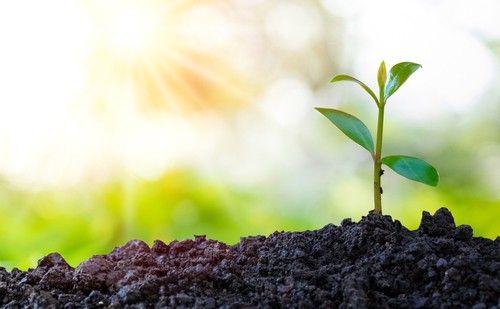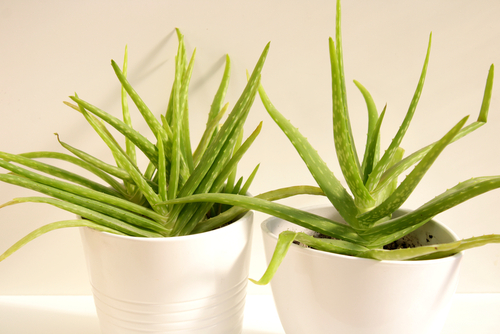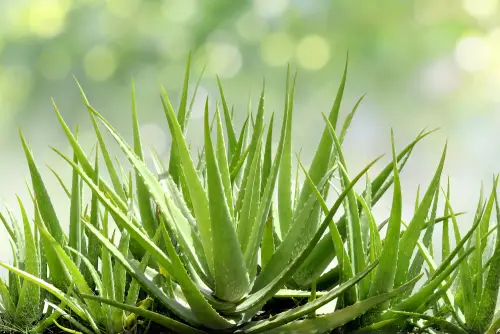Aloe vera plants are popular houseplants because of their low maintenance and numerous health benefits. However, sometimes these plants can start growing sideways, which can be concerning for plant owners.
If you notice your aloe plant growing sideways, there could be several reasons for this.
Understanding the growth pattern of an aloe plant is essential to determine why it is growing sideways. Aloe vera plants grow from the center and produce offsets, also known as pups, that grow around the mother plant.
As the pups mature, they can cause the plant to become top-heavy and start leaning to one side. Additionally, if the plant is not getting enough sunlight, it can start growing sideways towards the light source.
There are several common reasons why an aloe plant might start growing sideways, including lack of sunlight, improper watering, and overcrowding. Fortunately, there are also several ways to correct this growth pattern and prevent it from happening in the future.
By understanding the reasons behind sideways growth and taking appropriate corrective measures, plant owners can ensure their aloe plants thrive and remain healthy.
Key Takeaways
- Aloe vera plants grow from the center and produce offsets, which can cause the plant to become top-heavy and start leaning to one side.
- Lack of sunlight, improper watering, and overcrowding are common reasons for sideways growth in aloe plants.
- Correcting sideways growth involves providing adequate sunlight, proper watering, and repotting the plant if necessary. Preventing sideways growth involves regular pruning and avoiding overcrowding.
More on this category:
- Why Is My Alocasia Polly Turning Yellow?
- Why Is It Called a Janet Craig Plant?
- Why Is Gravitropism A Crucial Plant Adaptation?
Understanding Aloe Plant Growth

Aloe plants are known for their unique growth habits. Understanding how they grow can help you identify why your plant is growing sideways.
1. Photosynthesis in Aloe Plants
Photosynthesis is the process by which plants convert sunlight into energy. Aloe plants, like all plants, rely on photosynthesis to survive. They require bright, indirect sunlight to thrive.
2. Natural Growth Strategy
Aloe plants have a natural growth strategy that involves growing sideways. As the stem lengthens and touches the ground, it will root new sections and shoot pups (small growth shoots) up. This increases the clump size of the plant. Therefore, if you notice your aloe plant growing sideways, it may be a natural growth strategy.
3. Lack of Sunlight
One of the primary reasons why an aloe plant may grow sideways is a lack of sunlight. In poor lighting conditions, the plant may lean towards one side from where it gets some light. To prevent this, provide 5-6 hours of bright sunlight daily.
4. Overwatering
Overwatering can also cause an aloe plant to grow sideways. Succulents like aloe vera require less water than other plants. It’s important not to overwater them as this can kill them.
5. Direction of Light Source
The direction of the light source can also cause an aloe plant to grow sideways. If you’re growing your aloe plant indoors and have it placed by the window, eventually the plant will start stretching sideways towards the sunlight. This can cause the plant to look wobbly.
By understanding the natural growth strategy of aloe plants, the importance of photosynthesis, and the potential causes of sideways growth, you can take steps to ensure your aloe plant grows healthy and strong.
Why Your Aloe Plant is Growing Sideways – 5 Common Problems
Aloe plants are known for their upright growth habit, but sometimes they can start growing sideways. This can be a cause for concern for plant owners who want their plants to grow healthy and strong. Here are some common reasons why an aloe plant might start growing sideways:
1. Lack of Sunlight

One of the most common reasons why an aloe plant will grow sideways is due to a lack of sunlight. Aloe plants require bright, indirect sunlight to grow properly. If the plant is not getting enough sunlight, it will start stretching sideways towards the light source.
To prevent this, provide 5-6 hours of bright sunlight daily. You can also rotate your plant occasionally to have even growth.
2. Inappropriate Watering
Overwatering or underwatering an aloe plant can also cause it to grow sideways. When the soil is too moist or too dry, the roots can start to rot or dry out, which can lead to the plant growing in a different direction.
To avoid this, water your aloe plant only when the top inch of soil is dry. Make sure the pot has proper drainage to prevent root rot.
3. Poor Soil Conditions
The soil conditions can also affect the growth of an aloe plant. Aloe plants prefer well-draining soil that is rich in nutrients. If the soil is too compact or lacks nutrients, the plant may start growing sideways. To fix this, repot your aloe plant in a potting medium that is well-draining and rich in nutrients.
4. Overcrowding and Pups
Aloe plants are clump-forming aloes that produce pups or small growth shoots. When the plant becomes overcrowded with pups, it can start to grow sideways. To prevent this, remove the pups from the main plant and repot them in their own pots. This will give the main plant more room to grow upright.
5. Potting Issues
The size and shape of the pot can also affect the growth of an aloe plant. If the pot is too small, the plant may become root-bound, which can cause it to grow sideways. If the pot is too wide, the plant may not have enough support to grow upright.
To fix this, repot your aloe plant in a pot that is slightly larger than its current pot. Make sure the pot has proper drainage to prevent root rot.
How to Correct Sideways Growth
If your aloe plant is growing sideways, there are several steps you can take to correct the issue and help the plant grow straight and healthy. Here are some tips to try:
1. Correcting Light Source
One of the most common reasons for sideways growth in aloe plants is a lack of sunlight. Aloe plants require bright, direct sunlight to grow properly. If your plant is not receiving enough sunlight, it may start to lean towards the light source.
To correct this issue, try moving the plant to a sunnier location. If you are growing your aloe plant indoors, you may need to provide supplemental artificial light to help it grow straight.
2. Watering Adjustments

Overwatering or underwatering can also cause your aloe plant to grow sideways. If the soil is too wet or too dry, the roots may not be able to support the weight of the plant, causing it to lean to one side.
To correct this issue, adjust your watering schedule. Aloe plants prefer well-draining soil and should be watered deeply but infrequently. Allow the soil to dry out completely between waterings.
3. Soil and Fertilizer Changes
Aloe plants require well-draining soil that is rich in nutrients. If the soil is too dense or compacted, it may not provide the proper support for the plant, causing it to grow sideways.
To correct this issue, consider repotting your aloe plant in a pot with well-draining soil. You may also want to add some fertilizer to the soil to provide the plant with the necessary nutrients. Aloe plants prefer a fertilizer that is high in nitrogen.
4. Repotting and Pruning
If your aloe plant is too large for its current pot, it may start to lean to one side. To correct this issue, consider repotting the plant in a larger pot that can provide more support.
You may also want to prune the outer leaves of the plant to reduce its weight and help it grow straight. Be sure to only prune the bottom leaves of the plant, as the top leaves are necessary for photosynthesis.
5. Providing Physical Support
If your aloe plant is leaning to one side, you may need to provide it with some physical support to help it grow straight. You can use a stake or support to hold the plant upright until it can support its own weight. Be sure to place the stake or support in the soil near the base of the plant to provide the most support.
6. Rotation and Positioning
Finally, rotating and repositioning your aloe plant can also help correct sideways growth. By rotating the plant every few weeks, you can ensure that all sides of the plant receive equal amounts of sunlight and grow straight. You may also want to reposition the plant in a different location to provide it with a better light source.
By following these tips, you can help your aloe plant grow straight and healthy. Remember to be patient and consistent in your care, and your plant will thrive.
Preventing Sideways Growth

There are several ways to prevent aloe plants from growing sideways. Proper care and maintenance are key to keeping your aloe plant growing upright. Here are some tips to help prevent sideways growth in your aloe plant:
- Provide Adequate Lighting: Aloe plants require bright, indirect sunlight to thrive. If your plant is not receiving enough light, it may start to stretch and lean towards the light source, causing sideways growth. Ensure that your plant is placed in a well-lit area, preferably near a window that receives plenty of sunlight.
- Rotate Your Plant: To ensure that your aloe plant grows evenly, rotate it every few weeks. This will prevent one side of the plant from receiving more light than the other, which can cause it to lean and grow sideways.
- Prune Your Plant: If your aloe plant is growing too large and is starting to lean or grow sideways, consider pruning it. Cut off any excess growth and fill in any gaps with fresh soil. This will help your plant grow straight and upright.
- Plant Your Aloe Outdoors: Aloe plants can be grown outdoors in warm, dry climates. If you live in an area with mild winters, consider planting your aloe outside. This will provide your plant with plenty of natural sunlight and prevent it from growing sideways.
- Use a Support: If your aloe plant is already leaning or growing sideways, you can use a support to help it grow straight. Place a stake or support next to the plant and gently tie it to the support using garden twine. This will help your plant grow straight and upright.
By following these tips, you can prevent your aloe plant from growing sideways and ensure that it grows straight and healthy.
Remember to provide adequate lighting, rotate your plant, prune it when necessary, plant it outdoors if possible, and use a support if needed. With proper care and maintenance, your aloe plant will thrive and grow beautifully.
Conclusion
A sideways growing aloe plant is a common problem that can be easily solved with proper care and attention. The most common reason for an aloe plant growing sideways is the direction of the light source.
If the plant is placed indoors and near a window, it may start stretching towards the sunlight, causing it to grow sideways. This can be resolved by rotating the plant regularly to ensure that all sides receive an equal amount of sunlight.
Another reason for sideways growth could be due to the plant’s natural tendency to spread out. Aloes will naturally grow sideways as the stem lengthens and touches the ground, resulting in new sections and small growth shoots. This is called air-layering and is a natural way for the plant to expand its clump size.
It is also important to note that overwatering and root rot can cause an aloe plant to grow sideways. If the soil is too moist, the roots may rot, causing the plant to lean or grow sideways. To prevent this, make sure to water the plant only when the soil is dry, and ensure that the pot has proper drainage.
In some cases, sideways growth may be caused by a lack of nutrients or inadequate soil. To ensure that the plant has all the necessary nutrients, use a well-draining soil mix and fertilize the plant regularly with a balanced fertilizer.
Frequently Asked Questions

How can I fix a stretched aloe plant?
If your aloe plant is growing sideways or stretching towards the light source, it is likely that it needs more light. One way to fix a stretched aloe plant is to move it to a brighter location, such as a south-facing window.
You can also rotate the plant regularly to ensure that all sides receive equal amounts of light. If the plant has become too stretched, you can cut off the top portion and propagate it to create a new plant.
Why is my aloe plant growing a long stem?
Aloe plants may grow a long stem if they are not receiving enough light or if they are overwatered. The stem is the plant’s way of reaching for more light, and it can become weak and floppy if it is not getting enough support from the roots.
To prevent this, make sure your aloe plant is getting enough light and water it sparingly.
Can I tie up my aloe plant to straighten it?
Tying up an aloe plant to straighten it is not recommended, as it can damage the plant and inhibit its growth. Instead, try moving the plant to a brighter location or rotating it regularly to ensure that all sides receive equal amounts of light.
Why is my aloe plant twisting?
A twisting aloe plant may be a sign of overwatering or poor drainage. The roots of the plant may be rotting, which can cause the stem to twist and become weak.
To fix this, make sure your aloe plant is in a well-draining pot and that you are not overwatering it. Allow the soil to dry out completely between waterings.
How do I straighten a crooked aloe vera plant?
To straighten a crooked aloe vera plant, you can gently bend the stem back into place. However, be careful not to break the stem or damage the plant. It is also important to address the underlying cause of the crooked growth, such as poor lighting or overwatering.
What does an overwatered aloe plant look like?
An overwatered aloe plant may have yellow or brown leaves, a mushy stem, and a foul odor. The plant may also be leaning to one side or appear wilted.
To fix an overwatered aloe plant, allow the soil to dry out completely before watering again and make sure the plant is in a well-draining pot.

Hey, I’m Lisa and I’ve been an avid gardener for over 30 years. I love writing, talking and living in the garden! Feel free to connect with me on my socials below


